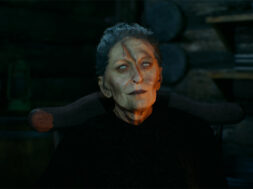Spoiler Alert: Do not read this article until you’ve seen the film.
After a buzzy, successful run at film festivals throughout the year, Blumhouse’s CAM is finally available for public consumption on Netflix. The film has earned positive accolades from reviewers (including Bloody Disgusting’s own Kalyn Corrigan) for its sex-positive messaging, its neon fuschia colour aesthetic and Madeline Brewer’s go-for-broke performance as lead Alice.
CAM is a confidently assured first film from director Daniel Goldhaber and screenwriter Isa Mazzei. The film is a technology-driven psychological thriller about Alice, an ambitious camgirl whose online identity is compromised by an identical-looking doppelganger who assumes control of her life. CAM is deeply concerned with issues of power, autonomy and the drive to excel in your chosen profession; these themes are all present in the masterful pre-title card opening sequence, which not only introduces audiences to Alice and the world of webcamming, but also anticipates and foreshadows the remainder of the film’s significant developments…all in what amounts to a six minute and 30 second short.
The film opens with Alice jumping into frame and apologizing for being late because she had to pee. It is evident from her verbal response to the television screen in front of her that this is a trademark statement from her, which immediately establishes the kind of rapport and an historical relationship Alice has with the clients in her group. There is also an element of theatrical performativity on display: despite the fact that the audience is unaware of exactly who this woman is, Alice is clearly playing into their wants and desires.
Although Madeline Brewer is acting solo in this scene, Goldhaber shoots her exchanges with the men on the television in a series of shot/reverse shots, just like a conversation. The screen displays the chat room where these virtual interactions occur: a large window is visible on the right that scrolls as comments and tips pour in. On the left-hand side is a mirrored image of Alice, or rather her camgirl persona, “Lola”.
This set-up immediately introduces the concept of a double – an identical-looking recreation of our protagonist who “exists” exclusively in the virtual realm under a different name. The distinction between the cam world and the real world is visually represented when Alice interacts with the “real” world of her mother’s hair salon, or shops for supplies at the dollar store: she wears less make-up, the lighting is dull and her clothes are comfortable, even drabby (not theatrical). On screen Lola is vibrant, dynamic and flirtatious; in real life, Alice is still driven, but her confidence is threatened by the cam girls who occupy higher ranks on the leaderboard. This insecurity even has its own visual tic: in real life, Alice frequently bites her nails.
The majority of the opening scene is a single night in Alice’s calendarized attempt to climb into the coveted top 50 camgirl rankings. She compliments her clients and expertly draws tips from them for various playful activities such as jumping up and down and dancing to a favourite track. In doing so, the personalities and tastes of various clients are revealed, including Tinker (Patch Darrragh) and high roller Barney (Michael Dempsey).
These activities also serve to educate the audience about how camgirling works. All of these interactions are aurally monetized; the soundtrack is filled with pings and other electronic exclamations that reinforce the level of engagement in the virtual room (even when Goldhaber isn’t visually displaying the chat screen). These sound effects create a dynamic energy, a Pavlovian response that mirrors the way society is increasingly addicted to social media and glued to our screens. Shortly thereafter, Alice will cheekily tease Barney with PG-rated T&A pictures on her phone in full view of her mother at the hair salon. Later, after she’s locked out of her account by her doppelganger, Alice becomes increasingly frustrated by her inability to control the consumption of her curated online personality and the financial damage it costs her.
Alice eventually turns to the sex work at hand, excavating three dildo options from a tickle trunk for the room to “vote” on. This is where Massei expertly introduces in the film’s psychology thriller component: Alice is harassed and threatened by an anonymous client – Visitor 003128 – who encourages, then demands that she cut herself with a knife. In addition to reinforcing the potential for online harassment, particularly for women, this swift change in tone foreshadows a narrative development later in the film when a celebratory milestone is cut short by an unfortunate turn of events. CAM suggests that these publicly accessible online forums offer potential for gainful employment and empowering independence, but they are also subject to hacks, identity theft and dangerous trolling. Consider the speed at which the comments in the chat turn from talk of dildos to egging “Lola” to harm herself in front of hundreds of viewers.
The fact that Alice does commit suicide – by slitting her throat – is a fascinating development. Considering how this opening scene plays, it (briefly) seems entirely possible that Alice is actually dead and this is a cold open in the vein of Scream and its countless copycats. After all, horror is filled with introductory scenes that are designed to hook audiences with a shocking act of violence.

It is quickly revealed, however, that Alice has faked her suicide as part of an elaborate stunt to garner attention and catapult the show from 65 to 53 on the site. This final revelation is a monumental piece of character work because it reinforces how dedicated and driven Alice is to her work (one of CAM’s dominant messages, regardless of how audiences feel about the nature of her work). Later Alice complains about #1 ranked Baby (Imani Hakim), whose camming is revealed to include little more than laying on her side on a pillow, complaining that a feather is poking her. Other camgirls are also glimpsed, and despite a few theatrical flourishes such as pouring body glitter on their cleavage and some light bondage, no one seems as invested as Alice in putting on a high quality, theatrical performance for their clients.
Of course, this drive and ambition, and the lengths to which Alice will go to entertain, factor heavily into the film’s narrative as Alice investigates why her identity was compromised and what it will take for her to regain control her life. In this way the opening clearly anticipates the film’s climatic showdown, another example of CAM’s mirrored approach to narrative construction.
A good opening sequence should lay the foundation for the film to come. By treating theirs like a standalone short, Isa Massei and Daniel Goldhaber expertly introduce their lead character, educate the audience on the world of webcamming and establish a series of thematic concerns and visual signifiers that anticipate and foreshadow future developments. CAM is a great addition to another incredibly strong year for the horror genre, and its masterful opening is one significant reason why it is so successful. “Gotcha” indeed.
CAM is now streaming on Netflix.









